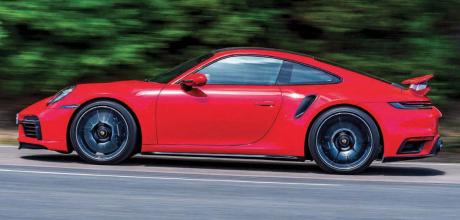Driving the range-topping 2024 Porsche 911 Turbo S 992
Offering supercar performance for sports car money, the 992 Turbo S stands head and shoulders above its rivals. We get schooled behind the wheel of this hugely entertaining 911...
Words James Fossdyke
Photography Barry Hayden
TOP OF THE CLASS
Driving the range-topping 992 Turbo S
Although it has plenty of heritage, the 911’s Turbo badge doesn’t sit especially comfortably in the current Porsche product range. Even the decidedly non-turbocharged Taycan EV is offered as a Turbo, relegating this once hugely symbolic moniker to the basic role of trim identifier. Considering every new 911 Carrera produces big power by way of twin turbochargers, and with the aforementioned Porsche EV proudly sporting a Turbo badge, is the 911 Turbo relevant in this day and age? Purists flocking to GT3 models would suggest not.
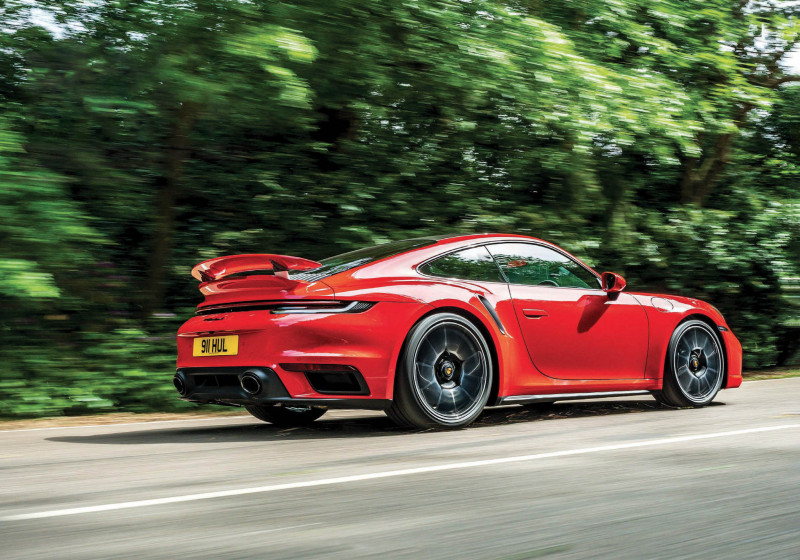
Porsche, however, says the 911 Turbo is just as important now as it ever was. Well, providing you add an S to the model name. To prove as much, the 992 Turbo S is treated to myriad upgrades to cement its place as the ultimate all-round 911. For kick-off, it comes with four-wheel drive as standard equipment, plus there’s an electronically controlled locking differential on the rear axle. Porsche Active Suspension Management (PASM) is included and, of course, there’s Porsche’s Dynamic Chassis Control (PDCC), dynamic engine mounts and massive Porsche Ceramic Composite Brakes (PCCB) lurking behind twenty-inch (front) and twenty-one-inch (rear) wheels. This is before we get talking about the width of the tyres, which measure more than twenty-five centimetres across. And that’s just at the front. The enormous rear tyres are a mind-blowing thirty-one and a half centimetres wide.
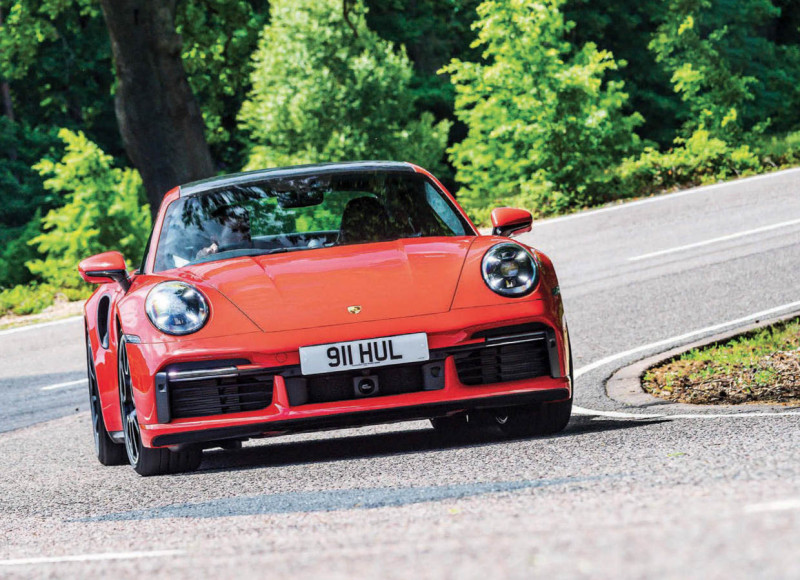
Perhaps fearing such enormous rear tyres might effectively turn the Turbo S into a steamroller, Porsche also widened the track by ten millimetres at the front and an eye-opening forty-five millimetres at the rear. Incredibly, the wheels still cover thirty-three percent of the car’s width. Even so, Zuffenhausen’s designers and aerodynamicists felt the need to do more with the 911’s rear wing, which is why there’s a massive ducktail-style appendage split in two (with a rising upper surface) at the rear of the Turbo S. This serious add-on is matched by a similar arrangement at the front, which helps to reduce lift at high speed.
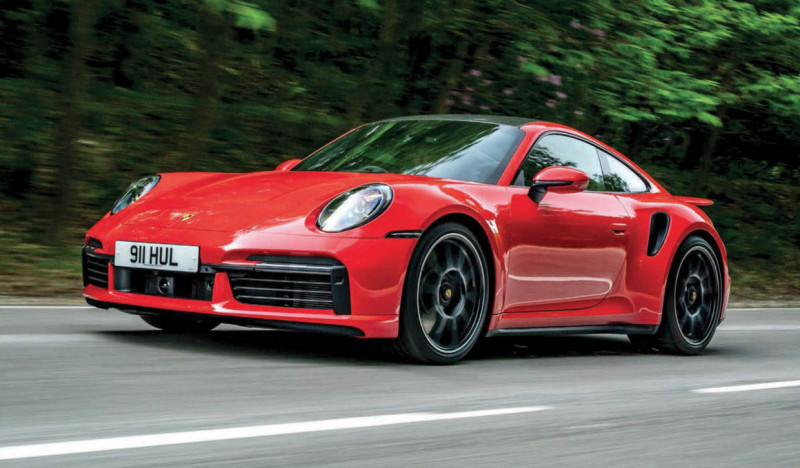
More evidence of optimised air management comes from the two massive intakes ahead of the rear wheels, sucking in air to feed the powerful twin-turbocharged flat-six. Speaking of which, Porsche spent a long time configuring the Turbo S’s powertrain. In essence, the company has taken the boggo Carrera’s three-litre engine and bored it out to 3.7 litres. Specifically, displacement is 3,745cc, although Porsche has rather generously decided to round that figure up to 3.8. We know better. Anyway, with two massive variable-geometry turbochargers, the six-cylinder boxer pumps out 641bhp and 590lb-ft of torque, which is distributed between those ginormous wheels by an eight-speed PDK semi-automatic gearbox, the Porsche Traction Management (PTM) multiplate- clutch system and Porsche Torque Vectoring Plus (PTV Plus), assisting with fully variable torque distribution.
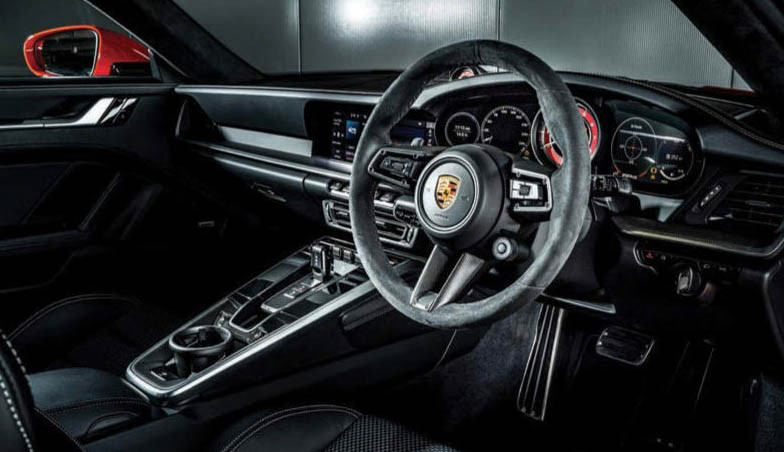
The result is a zero to 62mph time of 2.5 seconds and top speed of 205mph, which means this beefed-up 992 accelerates almost a second quicker than a 992 Carrera 4S and more than half a second less than a 992 GT3. In fact, it’s faster from standstill to 62mph than a Ferrari 296 GTB. It’s worth noting, we’re quoting Porsche’s officially published figures, which over the years, have proved to be somewhat conservative. With favourable conditions, the Turbo S might be even quicker than buyers are led to believe.
Truth be told, the Turbo S is bordering on being too quick and too fast. This sort of acceleration is just too physically demanding to be considered properly enjoyable anywhere other than a race circuit. You can feel it rearranging your internal organs and thudding the back of your bonce into the head restraints. Make no mistake, the 992 Turbo S is savagely quick, but this trick gets surprisingly tiresome surprisingly quickly.

In the real world, and certainly on the public road, you’re unlikely to use anywhere near this pace of acceleration very often, although we concede it’s nice to have at your disposal, just in case. Your mates will certainly be impressed. Arguably better than the Turbo S’s neck-snapping acceleration is the noise from its substantial tailpipes when giving the flat-six a proper workout. Our test car came with the optional gloss black sports exhaust (commanding a £2,180 premium), which snarls and barks like a wounded jackal as you wring out the engine. On overrun, the system pops and crackles like a firework display in a bowl of Rice Krispies, managing to startle pedestrians, other drivers and eliciting a wide grin from the infantile idiot (me) behind the wheel.
The soundtrack isn’t as visceral as that of the new GT3, not least because Porsche retained all the soundproofing found in the standard 992 Carrera coupe, but the Turbo S still makes a deeply satisfying din. It’s somewhere between the aristocracy of a big GT car and the untamed lunacy of a supercar. That’s quite the middle ground.
When it comes to handling, you could argue the Turbo S continues to occupy the middle ground to great effect, but to do so would be to damn this masterpiece with faint praise. With previous generations of 911, the Turbo S had a tendency to feel heavy and unrefined, a kind of sledgehammer to the corresponding GT3’s scalpel, but times have changed and so has the Turbo S.
SELECTION PACK
Despite the blood and thunder of its straight-line performance, the 992 Turbo S retains some of the 911’s classic characteristics, including an astonishing sense of balance, which somehow surfaces despite the engine being mounted at the rear. There’s no sense of understeer and general steering feel is sublime, just as it is in a 992 Carrera GTS. All this is before you start fiddling with the Sport Chrono Package’s various driving modes and the suspension settings. In Normal mode, the car strikes a balance between comfort and handling, but when you firm up the suspension and spin the steering wheel-mounted mode selector to Sport Plus, any question of balance goes out the window. Driver assistance is dialled back and the car instantly feels tauter and less forgiving. It feels like a ballerina on points. It handles that way, too.
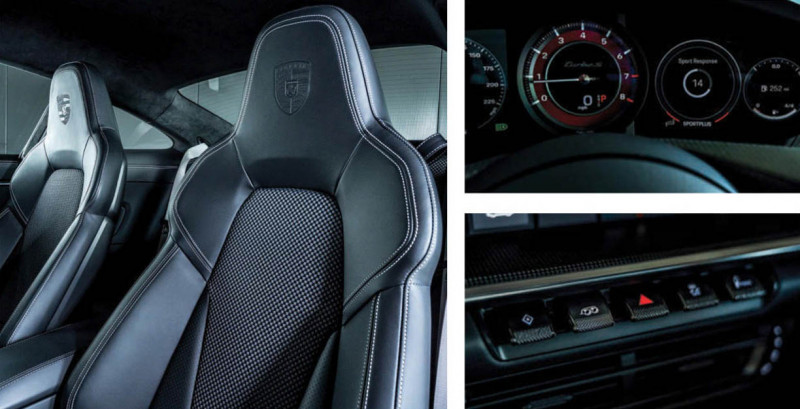
Admittedly, any Turbo S feels a smidge heavier than your average supercar, but then this 992 version tips scales at 1,640kg. The sense of carrying weight is therefore understandable. To put this into context, a new PDK-equipped GT3 is more than two hundred kilograms lighter. And yet, despite the extra bulk, the Turbo S feels smooth and unhurried, no matter how fast you’re going. You can feel the weight shifting around, unloading the inside tyre in fast corners, but the car remains completely controllable, as though it’s quite happy to step back from the brink at any moment.
Combine this with the pretty much imperceptible activity of the all-wheel drive system and mountainous grip on even the greasiest of roads, and the Turbo S is an absolute peach of a Porsche. While it may not have lightness on its side, it’s still incredibly poised and fantastically intuitive to drive, offering a ballistic turn of pace and seemingly endless traction. We don’t wish to keep labouring the point, but though the Turbo S may not be as sharp as the current GT3, it’s no longer a brash, unsubtle sports car.
If there’s a criticism of the Turbo S driving experience, it can only be concerning engagement. Put it this way, this big-power 911 has such copious capability, it feels stable and composed at any speed, which makes it feel entirely approachable, almost too easy to drive. It lacks the fickle, highly strung tetchiness characterising so many high-performance cars.
Surprisingly, considering the Turbo S’s awe-inspiring pace and range-topping credentials, the cabin doesn’t feel vastly different from that of a standard 992 Carrera. You get the same layout and the same superb attention to detail, including folding cup holders on the passenger-side dash and a ‘hybrid’ instrument cluster seamlessly combining digital and analogue readouts. As is so often the way with Porsche products, the design and quality of materials used here is first-rate.
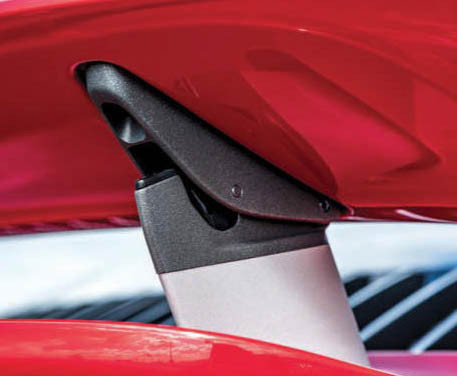
As is the latest-generation Porsche Communication Management (PCM) infotainment system, complete with near eleven-inch touchscreen display and now offered across the 911 range. Cleaner-looking and more modern than ever before, this version of PCM is a real step forward, not least because it’s now offered with Android Auto smartphone connectivity, as well as linking to Apple CarPlay. Even if you use only PCM’s proprietary features, you’ll enjoy sharper responses and less fiddly menus, making the system much easier to use on the move. And, of course, it’s linked to the Sport Chrono clock (with integrated lap timer) and the main instrument cluster, which combines an analogue rev counter with configurable seven-inch thin-film-transistor (TFT) displays on either side.
While the Turbo S’s cabin might be beautifully appointed and fabulously constructed, it doesn’t provide many clues to the model’s lofty position in the 911 range. Granted, you can see those massive rear haunches in the door mirrors, which is a bit of a giveaway, but otherwise, you simply get a Turbo S motif on the rev counter. That’s about it.
There is welcome additional equipment, though, including Adaptive Sports seats Plus, offering memory functionality and eighteen-way electric adjustment (including bolsters), which makes the Turbo S’s cabin a very comfortable place to be. It’s also practical, providing you only compare measurements with supercars and other 911 models — the luggage lid at the front hides much the same cargo tub as any other 992, amounting to 128 litres of space, which means it isn’t especially roomy, but it is at least a sensible shape. A couple of soft holdalls should go in there without too much trouble. More useful is the carpeted rear cargo space behind the back seats. If you’re still struggling, you could always store bags on the back seats themselves.
While we appreciate this might sound naff to Cayenne owners, it’s just another example of the Turbo S’s inherent usability. For all its dynamic prowess, this special 911 is remarkably supple, with much the same ride quality as a Carrera. Yes, the Turbo S is a little unforgiving at low speeds, and the occasional bump will send a jolt through the stiff body structure, but considering the performance on offer, this is a remarkably smooth ride. Of course, it gets quite firm — possibly too firm for many UK roads — when the suspension is running its stiffest setting, but it’s important to realise this mode is primarily offered to satisfy trackday enthusiasts. Leave it alone, and you’ll find few other premium-marque sports cars can match the motorway comfort of the Turbo S, which is more akin to that of a GT car. Certainly, it’s more comfortable than a 992 GT3 or even the latest Carrera GTS, which we review later. .
SIBLING RIVALRY
All of which lends plenty of credence to the idea of the Turbo S staking its claim as the ultimate 911 all-rounder. If nothing else, the way this Porsche stacks up so well alongside supercars, grand tourers and other sports coupes is testament to its wide range of capabilities. There is a caveat here, though. Yep, we reckon there’s another new 911 just as good. We’re talking Carrera 4S. Admittedly, the 4S is slower in a straight line and in corners. It’s also true to say it isn’t significantly more comfortable than the Turbo S. And, we’ll admit, although the differences are perceptible, they’re hardly enormous.
The Carrera 4S is, however, considerably cheaper. In fact, Porsche pitches the 4S at a significant sixty thousand pounds less than the cost of entry to 992 Turbo S ownership, which starts at £168,900. The Carrera GTS is around £45,000 cheaper, the GT3 is about £35,000 less to buy. That’s a lot of money. In fact, the money you’d save if you picked a Carrera 4S — great to drive, beautifully built and, by the standards of most other sports cars currently available, enormously quick — ahead of the Turbo S would be enough to pay for a whole new Macan. For some (or even most) owners, two Porsches is better than one. But for those who want an everyday supercar, rather than an everyday sports car, the 992 Turbo S undoubtedly holds huge appeal. In supercar company, Porsche’s 911 range-topper is far cheaper than most of its rivals and marginally faster in a straight line, as well as being more practical. As a result, it’s one of the most complete sports cars on sale today. More than this, it’s a work of genius.
Above Despite being marketed as a 3.8, the Turbo S flat-six is a 3,745cc boxer based on the three-litre power unit from the 992 Carrera models.
Above Due to the presence of a dedicated Wet driving mode and tyres specially developed for damp conditions, Porsche claims the Turbo S performs better away from dry surfaces, citing quicker Nürburgring lap times when the car was tested in inclement weather.
THE WAY THIS PORSCHE STACKS UP SO WELL ALONGSIDE SUPERCARS, GTs AND OTHER SPORTS COUPES IS TESTAMENT TO ITS WIDE RANGE OF CAPABILITIES
Above Centre-locks measure twenty inches at the front, twenty-one at the rear, hugging Porsche Ceramic Composite Brakes (PCCB).
Below Porsche Active Aerodynamics (PAA) provide an automatically deploying front spoiler, active cooling flaps and a doubleshelf rear wing raising.
TECH SPEC
- Model 2024 911 (992) Turbo S
- Price Coupe range from £87,330, Turbo S Coupe from £168,900
- Powertrain 3.8-litre flat-6
- Economy 23.0-23.5mpg
- CO2 emissions. 271-278g/km
- Top speed 205mph
- 0-62mph 2.5 seconds
- Max Power 641bhp at 6,750rpm
- Max Torque 590lb-ft at 2,500-4,000rpm
Above Interior is typically first-rate and is available in a range of finishes, including twin-tone leather with quilted centres and contrasting stitching.
ARGUABLY BETTER THAN THE NECK-SNAPPING ACCELERATION IS THE NOISE FROM THE TAILPIPES WHEN GIVING THE FLAT-SIX A PROPER WORKOUT
Above The Turbo S’s outstanding performance is matched with ease-of-use driving, but does this present the potential for reduced driver engagement?


